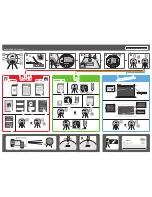
4-002
Precautions for Fault Diagnosis
1. Precautions for Fault Diagnosis
Park the machine on level ground. Make sure that the safety pins are engaged, wheels
chocked and parking brake applied.
When working with other workmates, use hand signals authorized, and keep people not
concerned away from the work area.
If the radiator cap is carelessly removed from a hot engine, hot coolant will gush out to
cause a burn. Remove the cap only when the engine has been cooled off.
Exercise care not to touch hot parts or not to get caught in rotating parts.
When disconnecting electric wires, disconnect the battery negative (–) cable.
When taking off plugs or caps from units which are under pressure such as hydlaulic,
water and air pressures, remove residual pressure first.
・
Fault dignosis is to determine the root cause of trouble. Repair faulty parts as quickly as
practicable, and prevent recurrence of the trouble.
・
Important when making a diagnosis is of course to well understand the structure and function
of the machines at fault. For effective fault diagnosis, however, it is of prime importance to have
a clear picture of the trouble concerned by contacting the operator.
1. When a trouble has occured, do not
attempt to disassemble suspected parts
blindly.
Disassembling in a hurry without careful
considerations will invite disadvantageous
situations as described below:
・
Parts which need not be disassembled
may be disassembled.
・
Tracing the cause of trouble will become
more difficut.
These will cause increased service costs
because of wasteful service hours, spare
parts or expendables like oil or grease. To
make matters worse, such a careless
practice will invite operator’s (customer’s)
distrust. For these reasons, a full
investigation and a prudent diagnosis in
accordance with fault diagnosis procedures
recommended are essential for efficient
fault finding proctices.
2. Questions to be addressed to the
operator (customer).
1) Are there any trouble other than the one
in question?
2) Had there been any unusual conditions
with the machine before the trouble has
occurd?
3) Has the trouble occured suddenly without
showing any signs of unusual conditions
in advance?
4) In what occation has the trouble occured?
5) Had the machine been repaired before
the trouble has occured? If so, when had
it been repaired?
6) Had similiar trouble occured before the
trouble has developed?
3. Before-diagnosis inspections
1) Perform daily inspections.
2) Perform other inspections necessary for
diagnosis.
4. Confirmation of trouble
Know the degree of the trouble. Determine
whether the trouble is attributable to a
structual defect etc or trouble caused by
incorrect handling.
*
When making the trouble recur in an
attempt to trace the source of the trouble
by putting the machine in motion, use
care not to cause more damages to the
machine.
5. Fault diagnosis
From the results of items 2 to 4 above,
narrow down the cause of the trouble, and
pinpoint its source by utilizing the diagnosis
flow chart.
★
The basic points of the diagnosis are:
1) Start from the simple portion.
2) Start from the portion having a high
probability.
3) Investigate related matters.
6. Fundamental remedy for a trouble
Even if a trouble has been rectified, it will
develop again if its cause is not determined.
It is of prime importance to grasp the very
cause of the trouble.
Содержание SW352
Страница 4: ......
Страница 5: ...SPECIFICATIONS ...
Страница 6: ......
Страница 12: ...MEMO ...
Страница 13: ...STRUCTURE AND OPERATION ...
Страница 14: ......
Страница 77: ...INSPECTION AND ADJUSTMENT ...
Страница 78: ......
Страница 91: ...FAULT DIAGNOSIS ...
Страница 92: ......
Страница 116: ...MEMO ...
Страница 127: ...DISASSEMBLY AND ASSEMBLY ...
Страница 128: ......
Страница 132: ...MEMO ...
















































